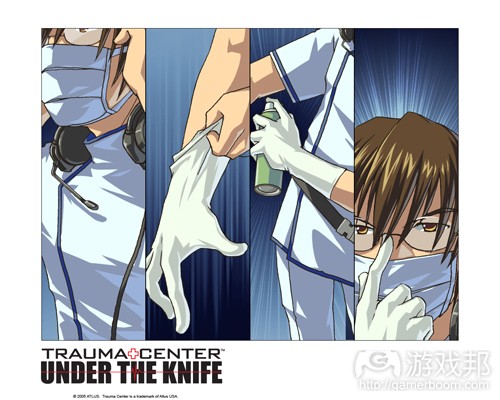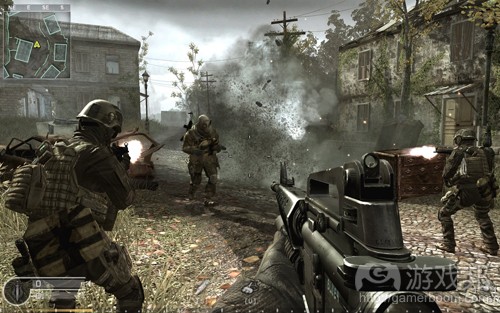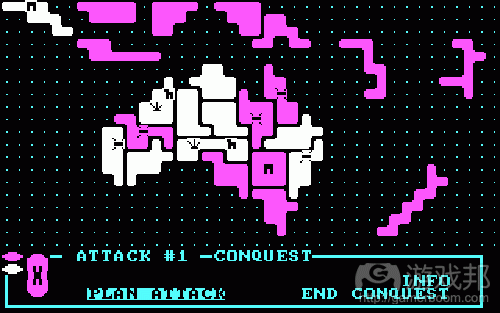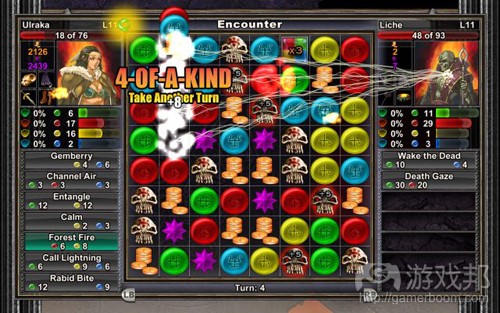解析游戏挑战的设计技巧和要求
作者:Soren Johnson
手术游戏《Trauma Center》是证明Nintendo DS可能改变我们的行业的最早的例子之一。把触控笔变成手术刀,设计师让玩家过了一把医生的瘾。不幸的是,这款游戏通过有时限的、困难的关卡,也模拟了医生在现实手术中面临的压力。
失败阻碍玩家的进度,这被证明是这款游戏的致命缺陷,因为游戏中根本没有难度等级——意味着玩家无法决定什么程度的挑战性是适合自己的。考虑到当下玩家群体组成的丰富多彩,从小孩到老人,这个问题必然会导致《Trauma Center》成为非常小众的游戏。
挑战总是游戏设计中的核心部分。然而,在电子游戏不再局限于街机后,大多数设计师意识到他们的游戏可以吸引更多人,如果他们能根据各个玩家的需求定制挑战的话。
动态难度
以《使命召唤4》为例,玩家可以在训练关卡中评估自己的表现,以寻找适合难度。其他游戏如《求生之路》则开发了动态难度算法,即调整敌人的刷出和命值下降速度,来适应玩家当前的表现和水平。
然而,动态难度也可能是很棘手的办法,因为类似于AI作弊,如果玩家可以觉察到“看不见的手”在操纵挑战,这种魔法就消失了。玩家必须感觉自己是在用固定的测量尺的衡量下,取得进步。RPG《湮灭》通过根据玩家角色的等级改变敌人的武器和技能,骗过了许多人。
一旦玩家看穿这种机制,他们就会动用许多可笑的策略,如永远不升级角色,这样敌人也永远是很弱的。更重要的是,这种动态破坏了RPG的核心特征之一——力量进程。因为有力量的提高,玩家培养出高级角色后,可以轻易地放倒之前可能秒杀自己的怪物。
可选择的难度
确实,RPG的核心机制——在每一次胜利的战斗后,玩家角色的力量都会稍微增强,可以当作是一种使玩家能够自己调节游戏难度的方法。 习惯于这种战斗系统的玩家可以根据自己的能力进展关卡,而偏好更温和的体验的玩家可以通过刷游戏培养角色。最重要的是,这个系统把控制权给玩家了,而不是给设计师。
尽管在进入游戏前选择难度级别的系统是早期的一种简单的创新,但直到最近,游戏才允许玩家在正常的游戏过程中切换难度。比如在《忍者龙剑传黑之章》中,玩家在每一次第三次死亡时都可以选择切换到“忍者狗”模式,在这个模式下,不仅敌人更弱了,而且Ryu还穿上粉色缎带作为惩罚。这种机制很快被其队游戏效仿,如《战神》。
确实,可选择的难度本身也可以成为核心玩法机制。网页游戏《桌面塔防》根本没有难度级别,但确实允许玩家加速游戏(从而增加挑战性)——提前触发进攻。然后,玩家的最终得分不仅根据杀死多少敌人,还要考虑游戏用时来计算。因此,打败默认速度的游戏只是入门,玩家必须学习如何掌握加速机制,以提高得分。
正交的挑战
《Thief》的难度级别虽然没有决定某个关卡中的敌人数量和警觉性,但指定了玩家在游戏过程中给自己设置的挑战。例如,“简单”级的任务要求可能是偷一定数量的宝石和古董,而“困难”级的任务要求可能是不仅完成任务,而且不能杀死任何一个守卫。
这些不同的模式都指向同一款游戏中的正交挑战,一种延长硬核玩家寿命的高招。其他例子还有《文明4》中的“One City Challenge” 和“Always War”选项,《暗黑2》中的硬核模式(永久死亡)。确实,Xbox Live成就也把一些硬核玩家原本不太感兴趣的东西当作非常规挑战。
此外,其他设置也可以在不改变难度的情况下调整游戏难度。例如,RTS可以同时提供难度设置和速度设置,这样玩家就可以深度更有难度的AI但更慢的速度,如果他不喜欢受到时间压迫的话。一个可惜被忘记的设置是,出现在早期游戏中的复杂度选项,如《M.U.L.E.》和《Lords of Conquest》。这种选项提供了简化版的游戏——比如资源类型更少,但仍然有能力完全的AI,可以给新玩家带来挑战。
挑战和惩罚
然而,有些游戏选择惩罚玩家而不是给他们公平的挑战。例如,有些游戏没有保存系统,当副本非常困难时,往往需要多名玩家才能通关。如果玩家必须重复一个冗长但简单的环节(或者更无耻地说,不可跳过的过场动画)才能开始挑战,那么游戏就是在惩罚玩家,而不是考验玩家。
对于这个问题,最体面的解决办法是,《波斯王子:时之砂》中的时间控制机制。玩家可以有限次地返回过去犯错的时间。这个系统避免了重复一个困难的跳跃,但仍然保持紧张感,因为时光倒流的次数是有限的。
另一个减少惩罚的例子出现在MMO中。《魔兽世界》减少死亡惩罚,这是向它的前辈如《无尽的任务》和《创世纪OL》学习的。通过移除尸体和经验损失,《WOW》使玩家能够按自己喜欢的方式玩游戏。不是只攻击永远不会带来经验损失和掉落物的简单的怪物,玩家可以深度困难的战斗,甚至返回安全区。
这样,对失败进行严厉惩罚的游戏就可以通过强烈鼓励玩家总是选择安全的路径来调整硬核玩法。在《魔兽争霸3》的流行MOD《DOTA》中,当玩家被杀死,游戏就奖励对手玩家金钱,这使笨手笨肢的菜鸟玩家在组队中非常不受欢迎。这种简单的动态机制使DOTA社区变得非常势利和不友好。
惩罚之后
策略/益智的杂交游戏《Puzzle Quest》继承了《WOW》的宽容属性,并进一步移除了所有形式的惩罚。玩家即使输了战斗仍然会得到奖励,虽然没有获胜时得到的那么多。事实上,这种机制有一个有意思的附加好处;《Puzzle Quest》不需要明显的保存系统。因为玩家从来不会受到任何惩罚,游戏可以在每一场战斗或活动后自动保存,即使玩家永远不会觉得有必要返回原来的存档。
这么宽容的系统并不适用于所有游戏。《生化奇兵》使用类似的机制,即玩家在游戏中死亡时可以免费重刷。另外,在玩家重刷时,敌人的命值并会重新补满,这意味着玩家可以在没有武器的情况下一点一点地到消耗敌人的命值,如果他愿意死足够多次的话。许多玩家滥用了这个特征,所以它最终成为一个可禁用的选项。
然而,这个问题可能一直是《生化奇兵》的目标玩家的期待导致的,而不是这个重刷机制的根本缺陷。《乐高积木之星球大战》使用了完全一样的机制,对于一起玩游戏的父亲和儿子是非常适合的。对于《生化奇兵》,硬核玩家期望游戏能迫使他们使用更高明的策略来进展,而不是简单的作弊。
也许最好的解决方案永远是,允许玩家进展,但根据一些恒定的指标来给他们的表现打分。《Elite Beat Agents》根据玩家的用时给出S、A、B、C和D作为表现评分。当玩家完成歌曲时,游戏会继续进行,但很少人不想返回去再试试。如果《Trauma Center》只采用这么一种简单的系统,它就不会只是一款有趣的游戏。设计师应该考虑不要让玩家总是争取相同的死板的目标。(本文为游戏邦/gamerboom.com编译,拒绝任何不保留版权的转载,如需转载请联系:游戏邦)
GD Column 10: Challenging Design
by Soren Johnson
The surgery game Trauma Center was one of the earliest examples of how the Nintendo DS could change our industry. By turning the stylus into a scalpel, the designers let players immerse themselves into the role of a doctor as never before. Unfortunately, the game simulated the pressures of actual surgery as well by presenting staggeringly difficult, time-pressured levels.
Failure blocked the player’s progress, which proved to be a fatal flaw for the game because there were no difficulty levels at all – no way for the player to decide what level of challenge was appropriate. Considering the wide demographic of gamers today, from young children to seniors, this decision doomed the game to a tiny slice of the DS’s audience.
Challenge has always been a core component of game design. However, after video games left the arcades – in which quick difficulty ramps were a necessity of doing business – most designers realized that their games could appeal to more people if they tailored the challenge to meet the needs of the individual user.
Dynamic Difficulty
Call of Duty 4, for example, measures the player’s performance during the training level to suggest an appropriate difficulty level. Other games – such as Left 4 Dead – have developed dynamic difficulty algorithms which adjust enemy spawns and health drops to the player’s current situation and demonstrated skill.
However, dynamic difficulty can be a tricky proposition as – similarly to AI cheating – if the player can see the invisible hand controlling the challenge, the spell is broken. Players need to perceive that they are improving against a fixed measuring stick. The RPG Oblivion turned off many people by scaling the weapons and skills of enemies directly in relation to the player character’s level.
Once this mechanic became obvious, many absurd strategies emerged, such as never leveling up to ensure that enemies always stayed weak. More significantly, this dynamic ruined one of the core features of an RPG – power progression. After developing advanced characters, players enjoy easily brushing aside monsters which earlier in the game could have destroyed them.
Elective Difficulty
Indeed, the core mechanic of RPG’s – that the player character grows slowly in power after each successful battle – can be seen as a way to give players the ability to adjust the game’s difficulty themselves. Gamers who feel comfortable with the combat system can push ahead through levels at the edge of their abilities while players who prefer a more comfortable experience can grind their way to overpowered characters before proceeding. Most importantly, this system puts the player in control, not the designer.
Although selecting a difficulty level at start was a simple, early innovation, only recently have games allowed players to switch between them during normal play. On every third death in Ninja Gaiden Black, players could elect to drop to “Ninja Dog” mode, which weakened enemies but also forced Ryu to wear pink ribbons as punishment. This mechanic – minus the mockery – was quickly adopted by other games, such as God of War.
Indeed, elective difficulty itself can be a core gameplay mechanic. The browser-based Desktop Tower Defense has no difficulty levels at all but does allow the player to speed up the game (and thereby increase the challenge) by triggering attack waves prematurely. Then, the final score is calculated from not just how many enemies were destroyed but also from how quickly the game finished. Therefore, beating DTD on the default speed is just the beginning as players must learn how to master the speed-up mechanic to start improving their scores.
Orthogonal Challenges
While the difficulty levels of Thief do not determine the number of guards nor their awareness on a given level, they do specify the challenges the player sets for herself during the level. For instance, the requirements of Easy may only be stealing a certain number of jewels and artifacts while Hard also necessitates finishing the level without killing a single guard.
These different modes suggest orthogonal challenges within the same game, a smart way to extend a game’s life for the hard-core. Other official examples include the One City Challenge and Always War options in Civilization 4 and the Hardcore mode (with permanent death) in Diablo 2. Indeed, Xbox Live Achievements provide a fantastic infrastructure for adding new challenges via unorthodox goals to games that might otherwise no longer interest core gamers.
Furthermore, other settings can adjust the challenge of a game without changing the difficulty, per se. For example, a real-time strategy game could have both a difficulty setting and a speed setting, so a player could try a more difficult AI but at a slower speed if he did not enjoy time pressure. One sadly forgotten setting is the complexity option that appeared in earlier games, such as M.U.L.E. and Lords of Conquest. This option provided a simpler version of the game – with less types of resources, for example – but still with a fully-capable AI that could provide a challenge for new players.
Challenge and Punishment
However, some games choose to punish players on top of giving them a fair challenge. Games without generous save systems, for instance, are vulnerable to being ruined by challenging sub-sections, which might require multiple attempts to pass. If a player needs to repeat a lengthy but easy section (or, more shamefully, a non-skippable cut-scene) before getting to the difficult bit, the game is punishing the player instead of challenging him.
One of the most elegant solutions to this problem was the time control mechanic in Prince of Persia: Sand of Time, in which the player is able to rewind past mistakes a limited number of times to try again. This system reduced the overhead of repeating a difficult jump to a relative minimum while still retaining tension because of the finite number of rewinds.
Another example of reducing punishment can be seen in the history of MMO’s. World of Warcraft famously reduced the penalty for death found in its predecessors, such as Everquest and Ultima Online. By removing corpse runs and experience loss, WoW enabled people to play the game they way they wanted to play it. Instead of only attacking easy monsters which would never cause the loss of experience or loot, players could attempt a difficult battle knowing that, in the worst case, they would be warped back to a safe location.
Thus, games with severe penalties for failure can actually warp the core gameplay by strongly encouraging players to always choose the safe route. Defense of the Ancient, the popular mod for Warcraft 3, rewards the opposite team with gold every time a player is killed, which makes bumbling new players extremely unpopular with their teammates. This simple dynamic makes the DotA community notoriously nasty and unpleasant, even by the meager standards of the Internet.
After Punishment
The strategy/puzzle hybrid Puzzle Quest took WoW‘s forgiving nature to the logical extreme by removing all forms of punishment from the game entirely. Players are even rewarded for losing battles, albeit much less than they would be for winning them. In fact, this mechanic has an interesting side benefit; Puzzle Quest has no need for a visible save system. Because players are never penalized in any way, the game can comfortably auto-save after every battle or action, knowing that a player will never feel the need to revert to an earlier save.
Such a forgiving system is not for every game. Bioshock used a similar mechanic by respawning dead players for free in Vita-Chambers placed throughout the game. Furthermore, enemies health rates were not reset on a player respawn, which meant that the player could chip away at any enemy with any weapon, including the wrench, if she was willing to die and be reborn enough times. This feature felt like an exploit to enough players that Irrational eventually patched in an option to disable Vita-Chambers.
However, the problem may have been with the expectations of Bioshock‘s intended audience instead of any fundamental flaw with the respawn mechanic. Lego Star Wars uses an identical mechanic, which is perfect for the target audience of a dad and a son playing together in a forgiving environment. For Bioshock, core gamers expected the game to force them to use advanced strategies to progress instead of an easy out.
Perhaps the best solution is to always allow players to progress but to rate their performance against some constant metric. Elite Beat Agents hands out letter grades of S, A, B, C, and D for each song performance based on the player’s timing. The game continues as long as the player finishes the song, but few will not want to go back to try and improve. If Trauma Center had only adopted such a simple system, the game may have become more than just an interesting footnote. Designers should take care not to head down the same dead-end.(source:designer-notes)
上一篇:开发者分享怪物设计的实用技巧











































 闽公网安备35020302001549号
闽公网安备35020302001549号